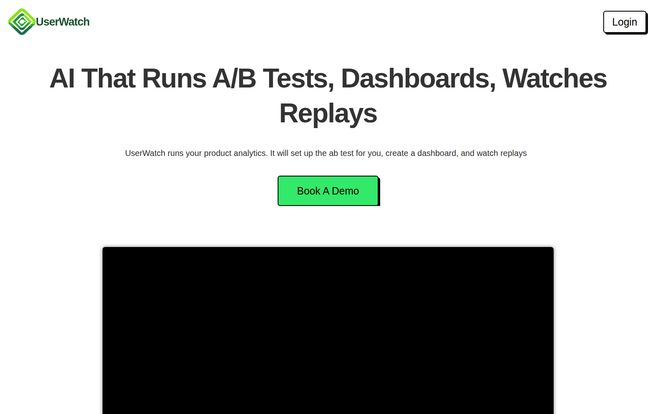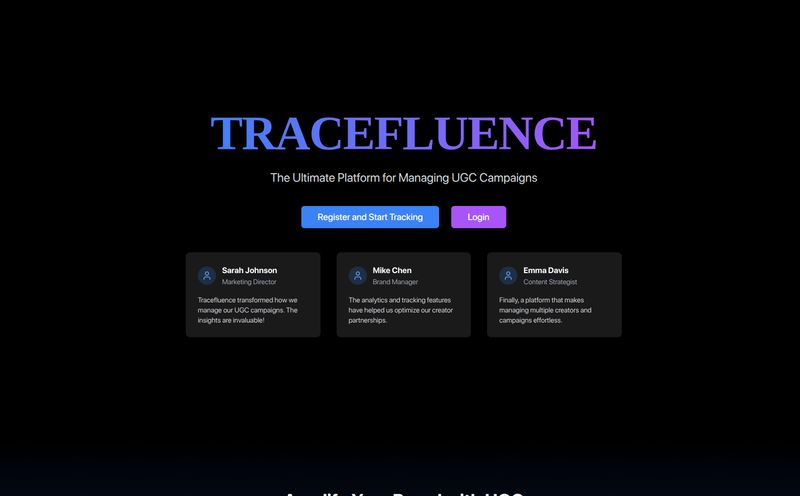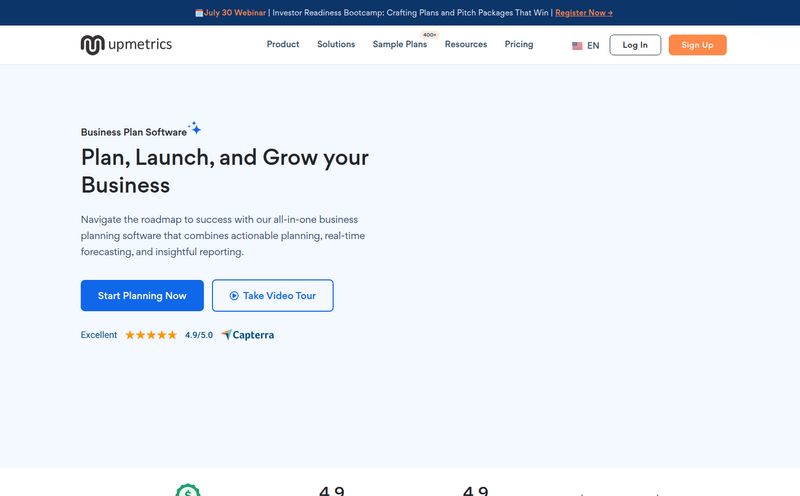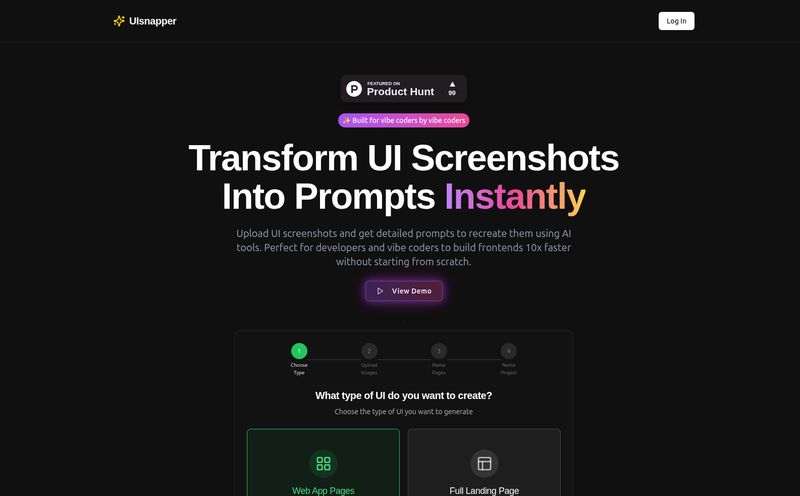Alright, let’s have a little heart-to-heart. If you’re in the SEO, CRO, or product management game, you know the grind. You’ve got your Google Analytics data, your heatmaps are glowing red in all the right (or wrong) places, but you still have that nagging question: Why? Why are people abandoning their carts on the final step? Why are they rage-clicking on a non-clickable element?
So, you turn to the tool we all love and hate: session replays. And for the next ten hours, you mainline user recordings. It's a voyeuristic and often soul-crushing experience. For every one “Aha!” moment, there are fifty clips of someone just aimlessly wiggling their mouse. I’ve always said it’s like panning for gold in a river of mud. You might find a nugget, but you’re gonna get dirty and tired doing it.
Then I stumbled upon a tool called UserWatch. The headline grabbed me: “AI That… Watches Replays.” Wait, what? An AI that does the most tedious part of my job for me? Color me intrigued. And a little skeptical, if I'm being honest.
So, What Exactly is UserWatch?
At its core, UserWatch positions itself as an AI-powered product analyst. Instead of just giving you the tools to record user sessions and build funnels (like, say, Hotjar or FullStory), it takes the next, critical step. It actually watches the recordings for you, analyzes them, and spits out actionable insights. It’s designed to be the bridge between seeing what users do and understanding why they do it, without you having to sacrifice a weekend to the replay gods.
It claims you can just tell it what to do—set up this A/B test, analyze that checkout funnel, create a survey—and it gets to work. The big promise is to stop the data overload and deliver a prioritized list of UX fixes that could actually improve your conversion rates and, y’know, make you more money.
The Agony UserWatch Wants to End
I saw an illustration on their site of a cartoon guy watching money literally fall down a storm drain, and I’ve never felt so seen. That’s exactly what a leaky conversion funnel feels like. Every user who drops off is a little coin vanishing into the sewer of bad UX.

Visit UserWatch
Manually trying to plug those leaks is a brutal process. You form a hypothesis, you watch dozens of replays to see if it holds water, you squint at a cohort analysis report, and then you try to convince your dev team to prioritize a fix based on your “gut feeling” and a handful of cherry-picked videos. It's not a great system. It's slow, it's subjective, and it's exhausting.
UserWatch is basically betting that an AI can do this faster and more objectively. It’s not just about finding the rage clicks; it’s about connecting them to a specific drop-off point in a funnel and telling you, “Hey, 35% of users who drop off here get stuck on this confusing date-picker. Fixing it could be worth an estimated $5,000 a month.” Now that’s a conversation a developer, and a boss, will listen to.
How This AI Analyst Gets to Work
From what I can gather, the process is built on a few key pillars. It's not just one magic trick; it’s a system.
It Automates the Grunt Work
The landing page talks about just telling UserWatch what funnel or A/B test you need. This is huge. The setup process for these things in other tools can be finicky. If it can simplify the initial configuration, that’s a win right there. It’s about lowering the barrier to getting started with real analysis.
The AI Session Replay Binge-Watcher
Here’s the main event. The AI sifts through the recordings, looking for patterns of frustration, confusion, and drop-offs. The promise of “NO more 10 hours of replay binging for 5 minutes of insights” is the siren song for every tired digital marketer. It’s not just flagging events; it’s building a narrative. It's trying to create the “exact stories to plan in your next sprint,” which is a fantastic way to put it. It turns abstract data into something a team can rally around.
It Prioritizes Fixes by Impact
This is probably the most compelling feature for anyone who has to justify their work to the C-suite. UserWatch doesn't just give you a laundry list of 100 things that are “broken.” It helps you triage. By connecting usability issues to drop-offs in a funnel, it can help you focus on the fixes that will plug the biggest leaks in your revenue bucket. This moves UX from a “nice-to-have” to a core business driver.
The Good, The Not-So-Good, and The AI-Powered Reality
No tool is a silver bullet, right? I've been around this block long enough to know that. So, based on what they're offering, here’s my take.
The Upsides are Pretty Clear
The time-saving aspect is undeniable. The value proposition is simple: trade hours of manual work for minutes of AI-driven insight. For a busy team, that’s massive. The insights it provides are designed to be actionable. It’s not just data; it’s a to-do list, and a prioritized one at that. The weekly reports also create a crucial feedback loop—something many teams forget. Did the change we shipped last week actually move the needle? Now you know.
Some Honest Caveats to Consider
First, a tool like this needs data to feast on. A lot of it. If your website only gets a few hundred visitors a month, the AI probably won’t have enough session data to find statistically significant patterns. This seems like a tool built for sites with established traffic that are looking to optimize, not for brand-new ventures.
Second, let’s be real, AI recommendations are not infallible. I see this tool as a hyper-intelligent junior analyst. It can do the legwork, find the patterns, and present a case. But you, the experienced professional, still need to provide the human oversight. You have the context and strategic understanding that an algorithm doesn’t. You're the senior strategist who has to give the final sign-off. Don't just blindly follow every recommendation.
Finally, the classic GIGO principle applies: Garbage In, Garbage Out. The effectiveness of UserWatch is going to be directly proportional to the quality and quantity of your session recordings. A poorly configured setup will only lead to poor insights, AI or not.
So, What's the Price Tag on This AI Assistant?
Ah, the million-dollar question. Or, hopefully, a lot less. Currently, UserWatch doesn’t have a public pricing page. Instead, you’ll see buttons for “Try For Free” and “Book a Demo.”
Typically, this pricing strategy means one of two things: the product is very new, or it’s geared towards an enterprise/custom pricing model. My guess is it’s the latter. Pricing is likely tailored to your site's traffic volume, the number of sessions you need analyzed, and the specific features you require. While some people hate this, I actually don't mind it for a tool this specialized. A demo allows you to talk to a human, explain your specific problems (like that god-awful checkout funnel), and see if the tool is genuinely a good fit before you see a price. It’s better than paying a flat fee for features you’ll never use.
Is UserWatch the Future of UX Research?
Look, the idea of AI taking over tedious tasks isn't new, but UserWatch is applying it to a very real, very specific pain point for people like me. It’s not trying to replace the UX researcher or the CRO specialist. It’s trying to be their most powerful tool. It’s trying to give them their time back and arm them with better data to make their case.
Will it be perfect? Probably not. Will it revolutionize the workflow for some teams? I think it has a real shot. If you’re at a company with decent traffic and you’re constantly feeling like you’re drowning in data you dont have time to analyze, then booking a demo seems like a no-brainer. At the very least, you’ll get a glimpse of what the future of product analysis might look like.
And if it means I can spend less time watching people forget their passwords, I'm all for it.
Frequently Asked Questions
What is UserWatch in simple terms?
UserWatch is a tool that uses artificial intelligence to automatically analyze user session recordings from your website. It identifies usability problems, tells you why visitors might be leaving, and suggests prioritized fixes to improve your site's performance and increase conversions.
How is UserWatch different from tools like Hotjar or FullStory?
While tools like Hotjar and FullStory are excellent for recording user sessions and creating heatmaps, they largely require you to do the analysis manually. UserWatch’s key difference is its AI analysis layer. It does the heavy lifting of watching the replays and extracting the “why” for you, providing a summary of problems and potential solutions.
Do I need to be a developer to use UserWatch?
Based on their messaging like “Just tell UserWatch what you need,” it seems designed for product managers, marketers, and UX researchers, not just developers. The goal is to simplify the process of setting up funnels and tests, making it more accessible to the people who need the insights.
Is UserWatch a good choice for a small blog or new website?
Probably not. AI analysis thrives on large datasets. To get meaningful insights and identify reliable patterns, UserWatch would need a significant amount of website traffic and session recordings. It’s better suited for established websites and applications looking to optimize their existing user flow.
How much does UserWatch cost?
UserWatch does not list public pricing on their website. They operate on a demo-based model, which usually means pricing is custom and tailored to your company's needs, likely based on factors like website traffic, number of sessions analyzed, and features required. You can find out by booking a demo on their site.



